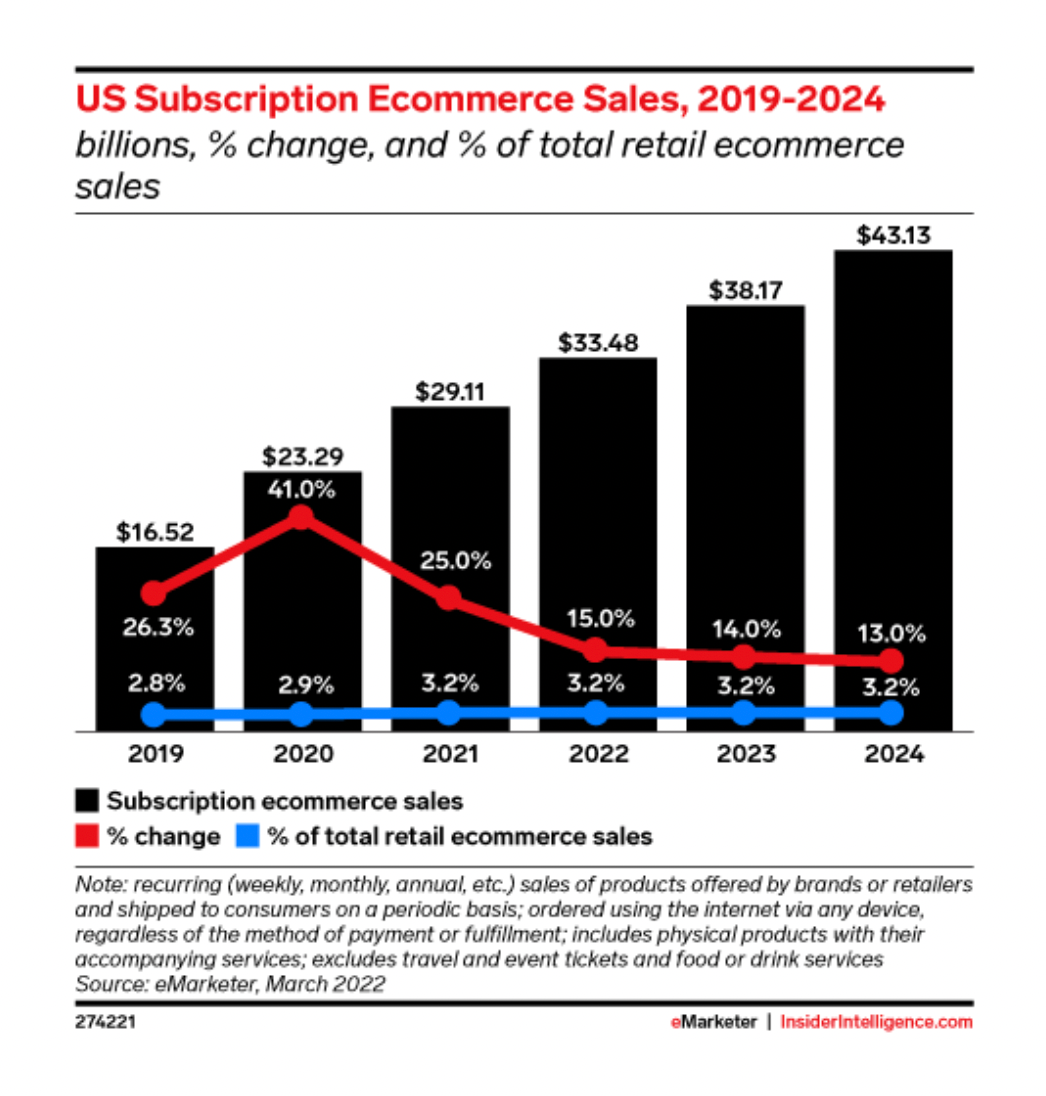Trend: Subscriptions, recurring revenue, and how to leverage them in 2023
I want to help you win in 2023. To help you understand the waves that are coming and how to leverage those in your leadership.
So far this year, we’ve covered how to capitalize on artificial intelligence, short-form video, social media, and podcasts.
Today, let’s talk about recurring revenue and the Subscription Economy.
It’s no surprise in the modern era that we’ve seen the rise of the Subscription Economy in nearly every area of our lives - music, entertainment, software, productivity, news, shopping, and so on.
The Subscription Economy Defined
The rise of recurring subscriptions in every area of consumer and business life. Customers are buying access always-on and anywhere, memorable experiences, ongoing value, and personalized service.
Let’s look at just one corner of the subscription economy since 2019 – e-commerce subscription sales:
With a spike in percentage growth in 2020 and 2021 during the pandemic, overall growth continues to be strong. 2022 subscription revenues are more than double those of 2019.
The average American had 6.7 subscriptions in 2022, up from 4.2 in 2019, according to Rocket Money, a personal finance app specializing in helping consumers manage their subscriptions.
In 2023, businesses and nonprofits will continue to experiment with recurring revenue programs to try to dial in revenue streams that have proven to be high value, high retention, and cash consistent. Here are just a few examples from the past week:
Barnes & Noble Takes Page From Amazon With $40-a-Year Membership Program (WSJ)
DoorDash grows its DashPass subscriber base by 50% (Insider Intelligence)
Pay-Per-Chew: More restaurants trying subscription programs (Associated Press)
As consumers have become more comfortable with monthly subscriptions, donors have as well, driving significant growth in monthly recurring donors.
The chart above comes from an analysis conducted by Blackbaud’s donorCentrics of 36 of the nation’s largest national fundraising organizations, showing 44% growth in sustaining monthly donors over the past five years.
Subscriptions and recurring revenue are opportunities for leaders of both nonprofits and businesses. Subscription programs:
Increase long-term value
Lower retention and reactivation costs
Reduce overhead
Provide consistent cashflow
Think of a snowball rolling down a proverbial hill. (There is snow on the ground today, so the metaphor is fresh on my mind.)
So many organizations start at zero every year. They have to go and renew or find new customers and donors. Budgeting starts at zero, and they hope they have the systems and processes to replicate last year’s numbers, maybe even with a bit of growth. But what if you could start the year with 20%, 50%, 80% of your revenue already secured? How would that change your ability to plan, invest, serve your customers, and do the work you do?
Here are three ways you might leverage the subscription economy in 2023 in your leadership:
Examine the role that recurring revenue plays in your organization
Many organizations already have a recurring revenue aspect to their income stream, whether or not the transactions are automated. What aspects of your model already have a recurring, predictable revenue element?
In 2023 how can you strengthen that recurring revenue portfolio?
I like to start by examining a few different areas from the past 12 months:
Acquisition - how many new recurring deals/customers/donors came in?
Revenue - how much income came in on a recurring basis?
Retention - how many previously recurring customers/donors churned?
Value - what is the long-term value of a recurring customer or donor?
Recurring subscription revenue is all about long-term value. My experience is that recurring customers are worth at least 3-5X that of their single purchase, single gift counterparts.
Part of this exponential increase in value is because recurring givers give and purchase longer, but it’s also because they tend to give and purchase more.
💡 Takeaway: Do you have any income today that is recurring? How might you grow that through new products/offers, reducing churn, or increasing acquisition?
Examine the role that recurring revenue plays in your sector
You may be uninspired by your current recurring revenue portfolio. Look around you – what other organizations in your space are succeeding with driving significant recurring revenue? What might you learn from them?
Every sector has its bright spots when it comes to recurring revenue, particularly in the Subscription Economy. Agencies have retainers. Financial firms have subscription fees. Software has SaaS. Nonprofits have recurring giving. Every industry has some element of a recurring revenue model, now including restaurants and vehicles – you can even subscribe to your doorbell.
Even if subscriptions are relatively new to your space, someone is experimenting with them. Pay attention to what they are doing, and consider whether there aren’t some things you might consider in 2023.
💡 Takeaway: Do you have any income today that is recurring? How might you grow that through new products/offers, reducing churn, or increasing acquisition?
Consider what a recurring revenue model could do for your organization
What would it mean for your business or nonprofit if you started each year with a predictable revenue base?
If you already have a significant recurring revenue base, I suggest you examine the holes in the bucket - where are you losing customers or dollars to churn, and how might you stop the leaks? Likewise, if you have a solid retention effort, what are the opportunities in acquisition or in upgrading your existing recurring customers or donors?
If you do not have a significant recurring revenue program, or if your gut tells you that you are just getting started, you’re in my favorite place! Imagine what could happen if you could achieve what even the top 25% of organizations in your space are seeing.
For example, in my experience in the fundraising space, 75% of nonprofits do not have a significant recurring revenue sustainer program. This is because they aren’t in the select few that can tap into sponsorship giving (e.g., child sponsorship) or membership giving (e.g., your local zoo, public television, public radio). This third category of nonprofit sustainer program only sees single-digit or low-double-digit percentages of revenue from recurring giving. This represents a massive opportunity for nonprofits like this to tap into what I call subscription philanthropy – recurring subscription giving for the rest of us.
If these non-sponsorship, non-membership nonprofits could catch the wave of subscription philanthropy, and if they grew 5% each year over the next ten years, that would represent $116 BILLION of much-needed good flowing into these charities.
What’s your forever promise?
One of the best books on the commercial side of subscriptions is by Robbie Kellman Baxter, The Forever Transaction: How to Build a Subscription Model So Compelling, Your Customers Will Never Want to Leave. In it, she describes the concept of the forever promise. In other words, if you want your customers or donors to “subscribe” to what you are doing and stay forever, what promise can you make to them that is worth forever?
I have a whole talk on what a forever promise looks like, but I’ll leave you with this short list to hopefully spark some thinking. The subscription economy is all about:
Moving from ownership to access
Moving from single payments to recurring payments
Moving from transactions to engaging experiences
Moving from one/two-way communication to community
Moving from periodic interaction to ongoing value
I’ve met Robbie and we’ve talked about the opportunity for nonprofits, and she agrees – it’s hugely untapped potential.
I believe in this trend so strongly that I’ve dedicated a significant portion of my time and our efforts at Imago Consulting to this topic.
If you are a nonprofit or a business, if you believe you have more to leverage with recurring revenue in 2023, and if you are interested in exploring how having some outside objective counsel and wisdom in this area, I’d love to chat. Just reply to this email.
Until next week… Surfs Up! 🌊
- Dave
About the Author | Dave Raley
Consultant, speaker, and writer Dave Raley is the founder of Imago Consulting, a firm that helps non-profits and businesses create profitable growth through sustainable innovation. He’s the author of a weekly trendspotting report called The Wave Report, and the co-founder of the Purpose & Profit Podcast — a show about the ideas at the intersection of nonprofit causes and for-profit brands.
Want to receive insights like this weekly?
Every Friday, we send out The Wave Report, highlighting one trend or insight “wave,” from donor and consumer trends to innovation in different industries or new models for growth.
Subscribe today to receive free weekly insights in your inbox here:


